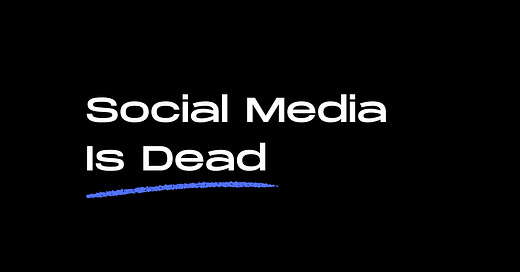Social Media is dead.
It’s full of bots. It causes divisions.
It's more polarizing every day.
It's a circus with the best-performing clowns usually getting the most attention.
Even established creators with millions of followers have changed their stance on social media followings.
Alex Hormozi recently said that followers don't mean anything; what matters is capturing (and keeping) attention.
Gary Vee also made similar comments on a podcast recently. To be fair, he's been saying this for a while.
And one of my favorite creators at the moment, Ed Lawrence, is also saying the same thing.
Ed recently closed down a YouTube channel with hundreds of thousands of subscribers and started again with a new channel (more on this to follow).
Social media followers mean less today than they did a few years ago. And I don't see this changing.
AI and Social Media
You have a lot of AI content being commented on by AI.
You are watching AI grow social accounts, with the following being bots, and the comments also coming from bots.
It's a wild time to be alive.
I don't think we've seen the peak of this just yet.
Social media platforms might turn it around... or maybe more people will wake up and see what's happening. Who knows.
But what I do know is this:
While you have AI bots talking to other AI bots in the comments section on social media, you're also seeing micro-communities pop up in different places.
A few years ago, I sold masterminds and consulting offers to other business owners.
They ranged in price from $1,000 up to $10,000.
I sold quite a lot of these offers.
This isn’t anything groundbreaking, except for the fact that I only had a few hundred followers.
There are creators with 100x the following I just mentioned, making much less money.
The difference?
Attention.
I had a micro-community of people who were genuinely interested in what I was doing, not millions who saw a 20-second reel that happened to go viral.
Remember I mentioned Ed Lawrence at the start of this newsletter?
He's a great example of what I’m seeing now (he just saw it over a year ago).
And what he saw was that large followings were becoming less and less important, especially if you get caught up in the vanity metrics of views, clicks, and wanting millions of followers..
..(which he did, by his own admission).
And even more so if you actually want to build something that makes a difference.
It’s why he closed his very large YouTube channel down.
What he saw (and what I’m now also seeing) is the rise of micro-communities.
People who are checking out of social media and looking for something with depth.
People who are done with the doom-scrolling and looking for something that matters to them.
One of the main places I see micro-communities popping up right now?
Substack and newsletters.
People who are checking out of social media due to the short-form dopamine addiction still want a way to connect, learn, and grow, just without the noise.
Micro-communities are a great place for this.
They are away from any kind of algorithms that exist on social.
But the biggest pull (in my opinion)?
Long-form content.
People keep saying the average attention span is like 13 seconds or something wild.
But I don’t believe this to be true.
People will sit and read a newsletter that takes 5–15 minutes to read.
They also watch 3 hour long podcasts, so you can’t tell me people have attention span problems.
I call these micro-communities because they are created by an individual who is usually interested in one or a few things.
And where those few interests overlap is the intersection of a very unique group of people.
Michael Easter
For example, Michael Easter has a micro-community (Two % Newsletter) with overlapping interests.
The intersection of those interests falls right within what interests me.
But while they interest me, they won't be of interest to 95% of other people.
But that’s the point, right? If these micro-communities appealed to anyone and everyone, they wouldn’t be as powerful.
People inside wouldn’t feel as connected.
When most people slow down enough to open up, they’re more social than they realize, especially around people with a shared outlook on life and overlap of values.
Why I’m building Slo Growth
Building a micro-community is exactly my intention with Slo Growth.
At the intersection of personal progress, creativity, and mastery, that’s where this community lives.
It’s literally where I live.
And it’s from that intersection that Slo Growth will grow.
Not through hype.
Not through chasing trends or scale for scale’s sake.
But through depth. Substance. Resonance.
The best part?
It’s already happening.
I’m already seeing this micro-community take shape in a way that feels more real, more energizing, and more meaningful than anything I’ve built before with my writing.
The conversations are richer.
The values run deeper. And it no longer feels like shouting into the void of social media.
This is what Slo Growth was built for.
And this is only the beginning.



